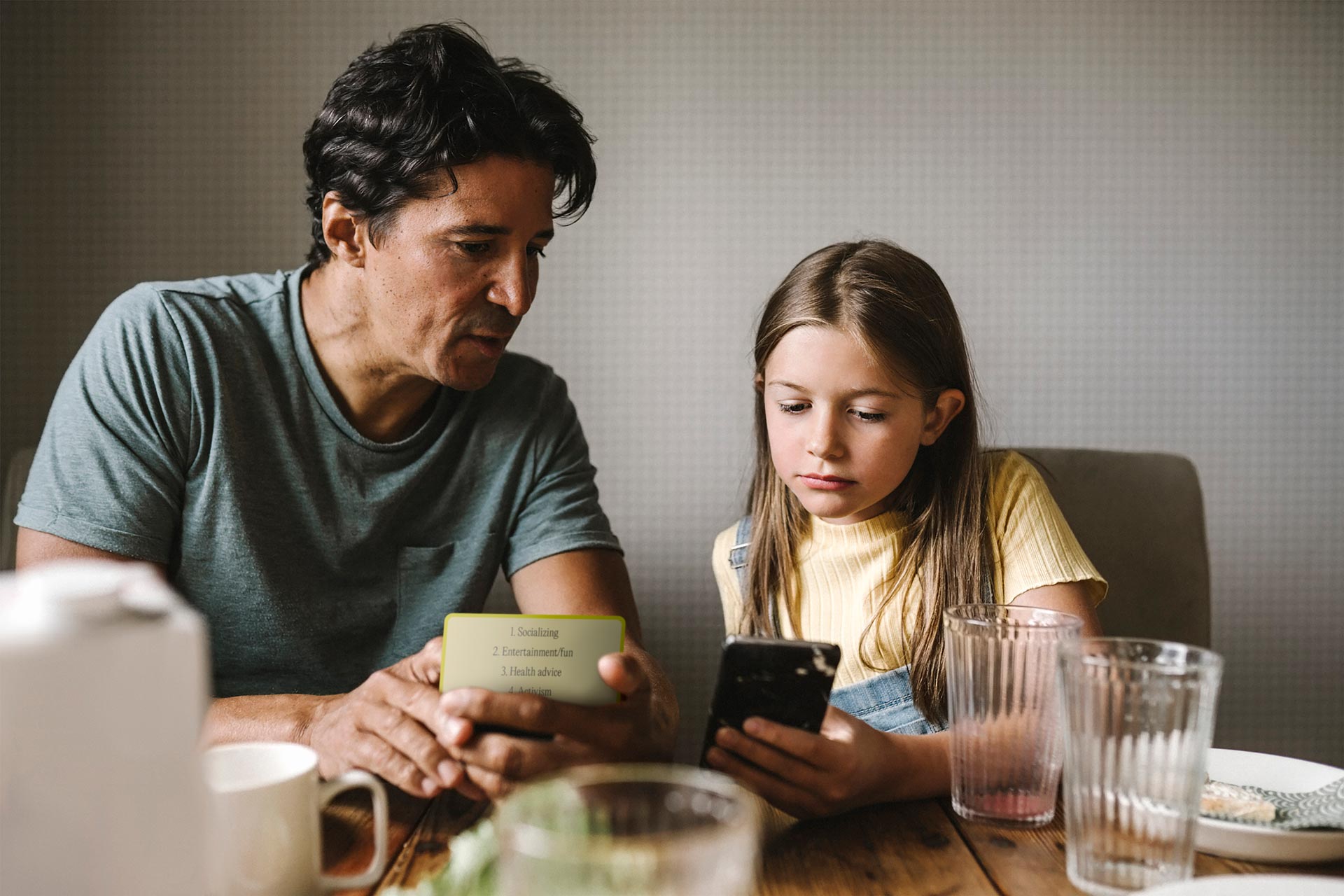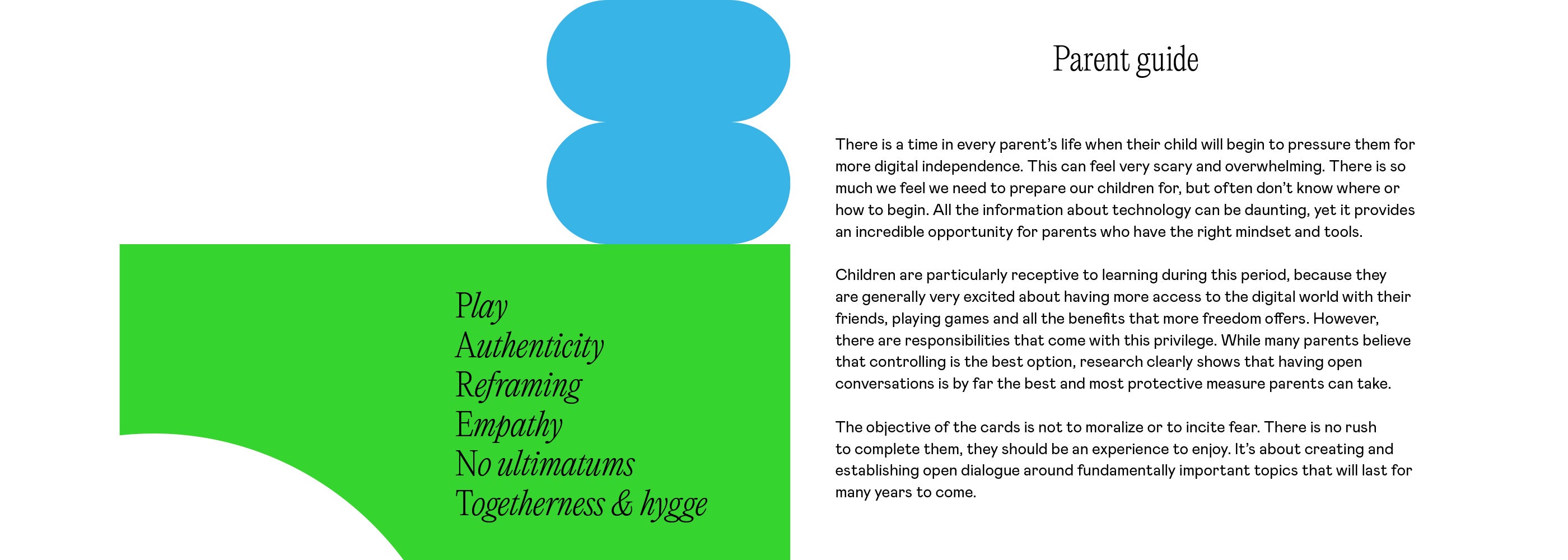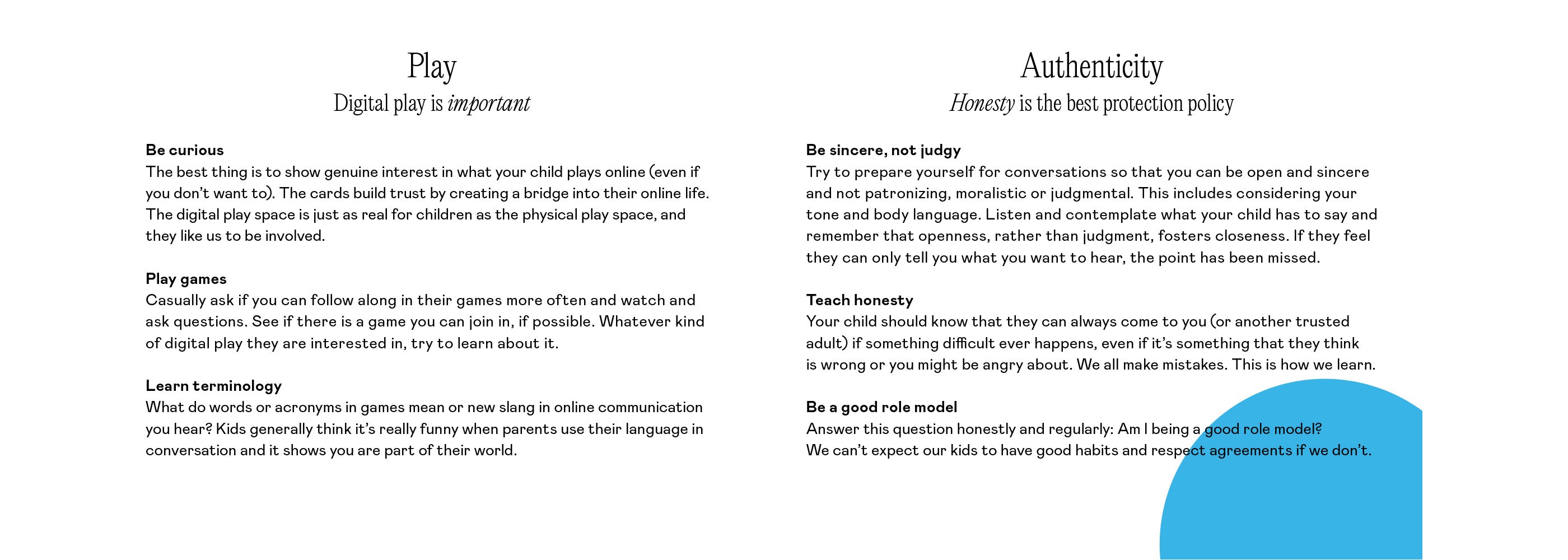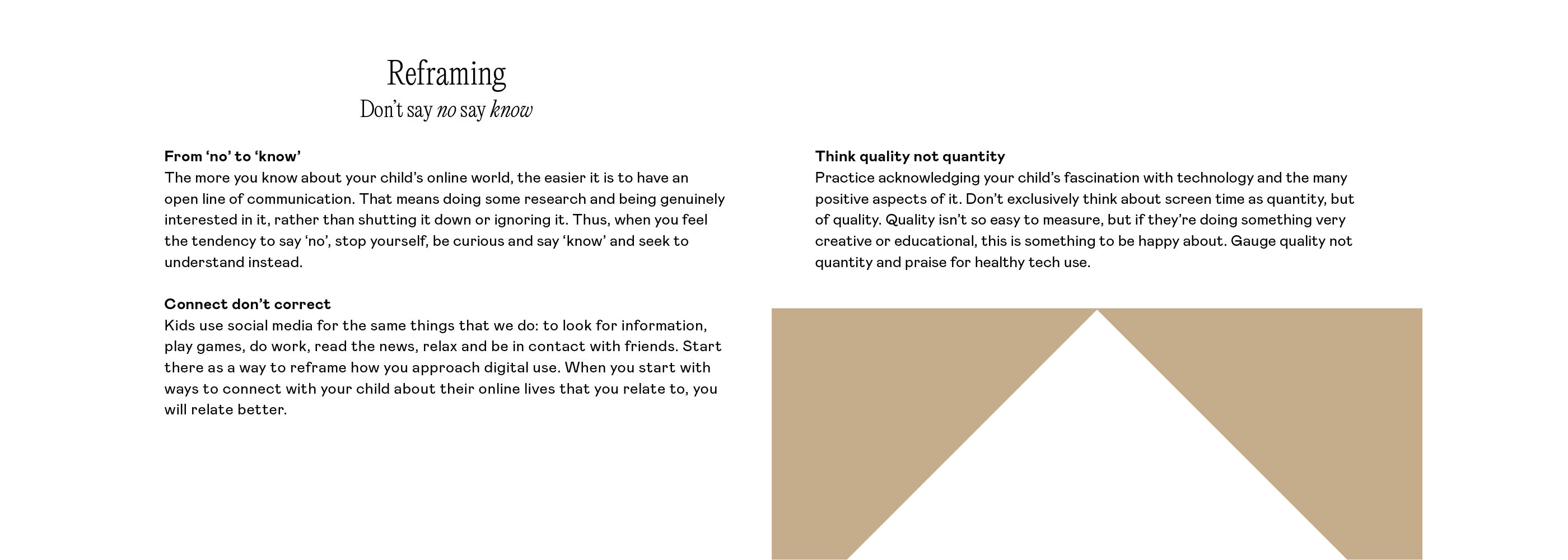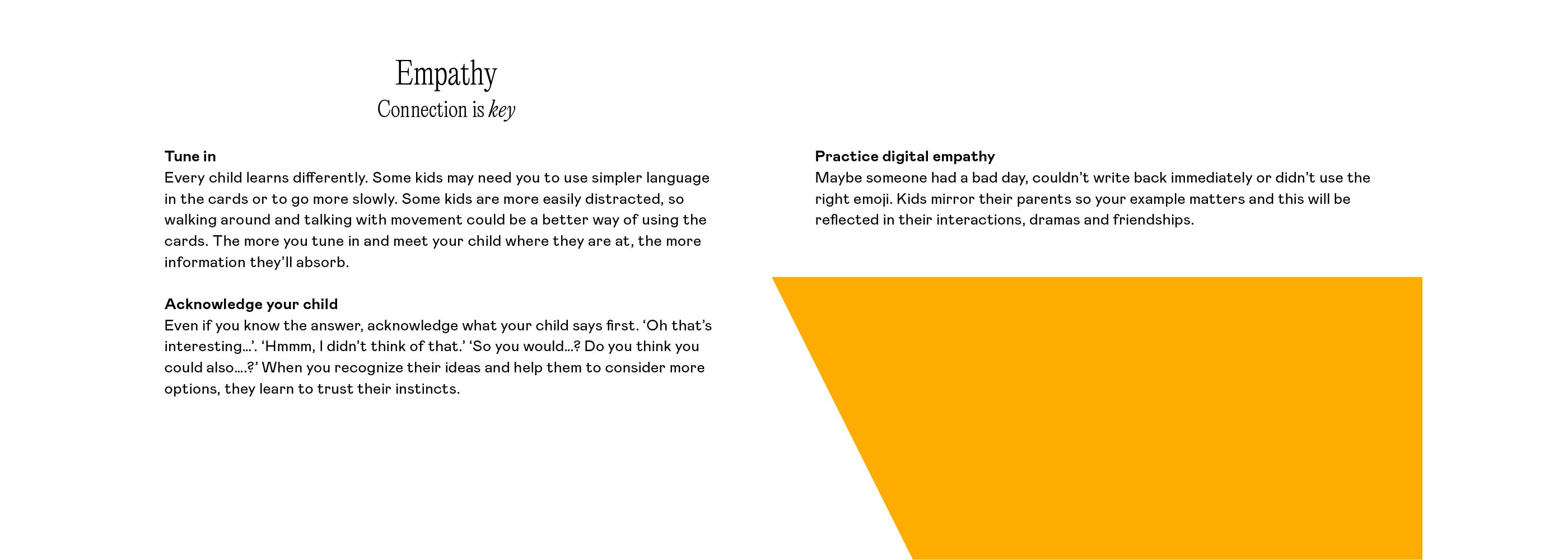Here is your Parent Guide
Thank you for your interest in us and what we do!
You can see our parent guide below or download it here

There is a time in every parent’s life when their child will begin to pressure them for more digital independence. This can feel very scary and overwhelming. There is so much we feel we need to prepare our children for, but often don’t know where or how to begin. All the information about technology can be daunting, yet it provides an incredible opportunity for parents who have the right mindset and tools.
Children are particularly receptive to learning during this period, because they are generally very excited about having more access to the digital world with their friends, playing games and all the benefits that more freedom offers. However, there are responsibilities that come with this privilege. While many parents believe that controlling is the best option, research clearly shows that having open conversations is by far the best and most protective measure parents can take.
The objective of the cards is not to moralize or to incite fear. There is no rush to complete them, they should be an experience to enjoy. It’s about creating and establishing open dialogue around fundamentally important topics that will last for many years to come.
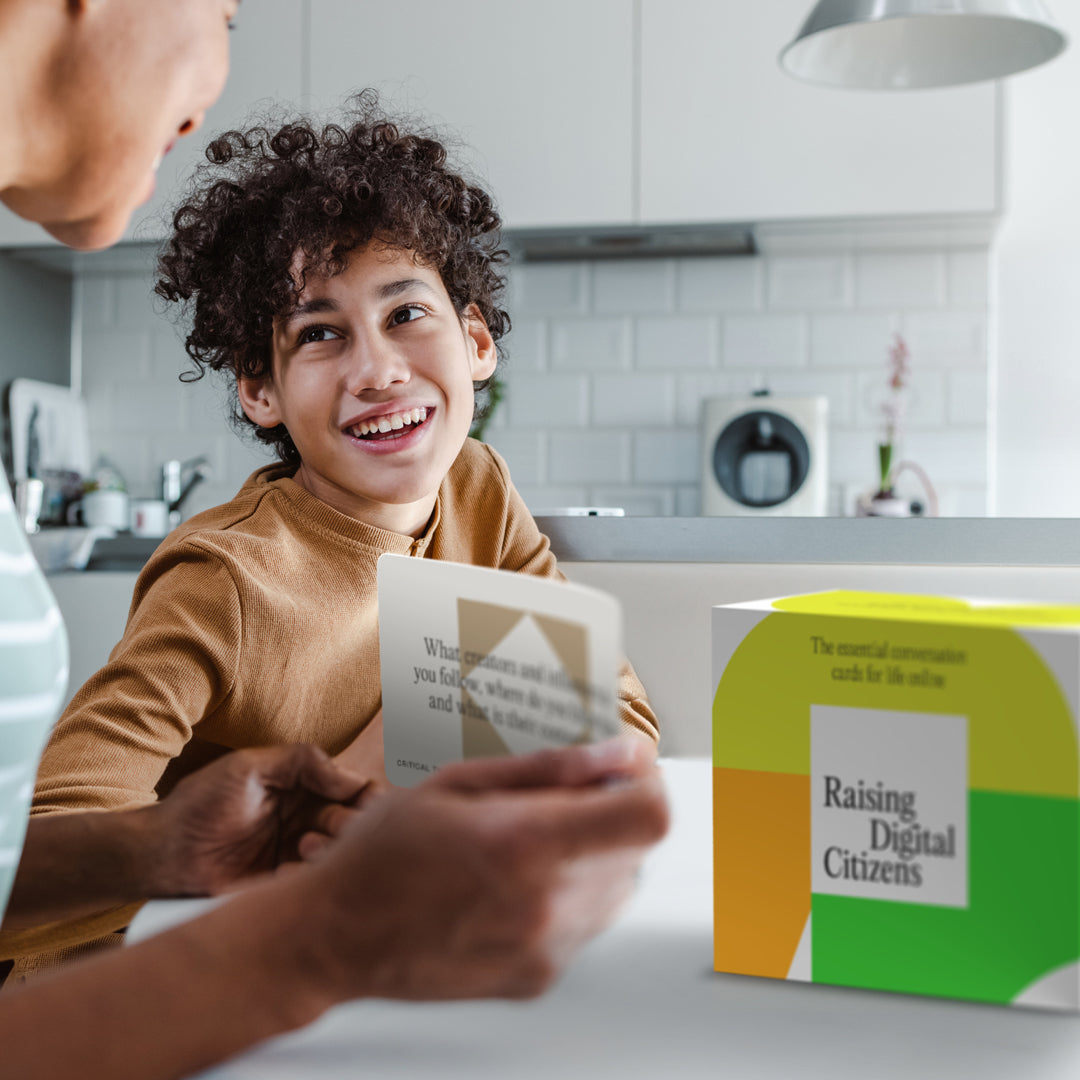
Play is important
Be curious
The best thing is to show genuine interest in what your child plays online (even if you don’t want to). The cards build trust by creating a bridge into their online life. The digital play space is just as real for children as the physical play space, and they like us to be involved.
Play games
Casually ask if you can follow along in their games more often and watch and ask questions. See if there is a game you can join in, if possible. Whatever kind of digital play they are interested in, try to learn about it.
Learn terminology
What do words or acronyms in games mean or new slang in online communication you hear? Kids generally think it’s really funny when parents use their language in conversation and it shows you are part of their world.
There is a time in every parent’s life when their child will begin to pressure them for more digital independence. This can feel very scary and overwhelming. There is so much we feel we need to prepare our children for, but often don’t know where or how to begin. All the information about technology can be daunting, yet it provides an incredible opportunity for parents who have the right mindset and tools.
Children are particularly receptive to learning during this period, because they are generally very excited about having more access to the digital world with their friends, playing games and all the benefits that more freedom offers. However, there are responsibilities that come with this privilege. While many parents believe that controlling is the best option, research clearly shows that having open conversations is by far the best and most protective measure parents can take.
The objective of the cards is not to moralize or to incite fear. There is no rush to complete them, they should be an experience to enjoy. It’s about creating and establishing open dialogue around fundamentally important topics that will last for many years to come.
Play is important
Be curious
The best thing is to show genuine interest in what your child plays online (even if you don’t want to). The cards build trust by creating a bridge into their online life. The digital play space is just as real for children as the physical play space, and they like us to be involved.
Play games
Casually ask if you can follow along in their games more often and watch and ask questions. See if there is a game you can join in, if possible. Whatever kind of digital play they are interested in, try to learn about it.
Learn terminology
What do words or acronyms in games mean or new slang in online communication you hear? Kids generally think it’s really funny when parents use their language in conversation and it shows you are part of their world.



Honesty is the best protection policy
Be sincere, not judgy
Try to prepare yourself for conversations so that you can be open and sincere and not patronizing, moralistic or judgmental. This includes considering your tone and body language. Listen and contemplate what your child has to say and remember that openness, rather than judgment, fosters closeness. If they feel they can only tell you what you want to hear, the point has been missed.
Teach honesty
Your child should know that they can always come to you (or another trusted adult) if something difficult ever happens, even if it’s something that they think is wrong or you might be angry about. We all make mistakes. This is how we learn.
Be a good role model
Answer this question honestly and regularly: Am I being a good role model?
We can’t expect our kids to have good habits and respect agreements if we don’t.

Don’t say no say know
From ‘no’ to ‘know’
The more you know about your child’s online world, the easier it is to have an open line of communication. That means doing some research and being genuinely interested in it, rather than shutting it down or ignoring it. Thus, when you feel the tendency to say ‘no’, stop yourself, be curious and say ‘know’ and seek to understand instead.
Connect don’t correct
Kids use social media for the same things that we do: to look for information, play games, do work, read the news, relax and be in contact with friends. Start there as a way to reframe how you approach digital use. When you start with ways to connect with your child about their online lives that you relate to, you will relate better.
Think quality not quantity
Practice acknowledging your child’s fascination with technology and the many positive aspects of it. Don’t exclusively think about screen time as quantity, but of quality. Quality isn’t so easy to measure, but if they’re doing something very creative or educational, this is something to be happy about. Gauge quality not quantity and praise for healthy tech use.
Honesty is the best protection policy
Be sincere, not judgy
Try to prepare yourself for conversations so that you can be open and sincere and not patronizing, moralistic or judgmental. This includes considering your tone and body language. Listen and contemplate what your child has to say and remember that openness, rather than judgment, fosters closeness. If they feel they can only tell you what you want to hear, the point has been missed.
Teach honesty
Your child should know that they can always come to you (or another trusted adult) if something difficult ever happens, even if it’s something that they think is wrong or you might be angry about. We all make mistakes. This is how we learn.
Be a good role model
Answer this question honestly and regularly: Am I being a good role model?
We can’t expect our kids to have good habits and respect agreements if we don’t.
Don’t say no say know
From ‘no’ to ‘know’
The more you know about your child’s online world, the easier it is to have an open line of communication. That means doing some research and being genuinely interested in it, rather than shutting it down or ignoring it. Thus, when you feel the tendency to say ‘no’, stop yourself, be curious and say ‘know’ and seek to understand instead.
Connect don’t correct
Kids use social media for the same things that we do: to look for information, play games, do work, read the news, relax and be in contact with friends. Start there as a way to reframe how you approach digital use. When you start with ways to connect with your child about their online lives that you relate to, you will relate better.
Think quality not quantity
Practice acknowledging your child’s fascination with technology and the many positive aspects of it. Don’t exclusively think about screen time as quantity, but of quality. Quality isn’t so easy to measure, but if they’re doing something very creative or educational, this is something to be happy about. Gauge quality not quantity and praise for healthy tech use.



Connection is key
Tune in
Every child learns differently. Some kids may need you to use simpler language in the cards or to go more slowly. Some kids are more easily distracted, so walking around and talking with movement could be a better way of using the cards. The more you tune in and meet your child where they are at, the more information they’ll absorb.
Acknowledge your child
Even if you know the answer, acknowledge what your child says first. ‘Oh that’s interesting…’. ‘Hmmm, I didn’t think of that.’ ‘So you would…? Do you think you could also….?’ When you recognize their ideas and help them to consider more options, they learn to trust their instincts.
Practice digital empathy
Maybe someone had a bad day, couldn’t write back immediately or didn’t use the right emoji. Kids mirror their parents so your example matters and this will be reflected in their interactions, dramas and friendships.

Teach respect, be respectful and you will be respected
Be curious, not furious
If you see your child looking at something you think they shouldn’t, remain calm and ask questions like ‘how did you get to that?’ or ‘what did you click on’? We want to help them become good digital citizens, not punish them for curiosity. It may be that your child has clicked on something by mistake or looked for content they heard about from friends. Children are naturally curious and search for things without realizing what they might find.
Don’t blame, reframe
If you see your child as sneaky or untrustworthy, you will react that way. If you see them as responsible and trustworthy, you will treat them as such. Children will often remember the immediate response from an adult, which lets them know if they can be open and honest or not.
Avoid ultimatums, focus on the agreement
It can be tempting to threaten to take away phones or technology, but remember what you want to achieve. Is blocking their social life and sense of belonging the most respectful and effective way of upholding boundaries in the long run? Focus on the agreement instead (see raisingdigitalcitizens.com) This way you can avoid power struggles and maintain respect.
Connection is key
Tune in
Every child learns differently. Some kids may need you to use simpler language in the cards or to go more slowly. Some kids are more easily distracted, so walking around and talking with movement could be a better way of using the cards. The more you tune in and meet your child where they are at, the more information they’ll absorb.
Acknowledge your child
Even if you know the answer, acknowledge what your child says first. ‘Oh that’s interesting…’. ‘Hmmm, I didn’t think of that.’ ‘So you would…? Do you think you could also….?’ When you recognize their ideas and help them to consider more options, they learn to trust their instincts.
Practice digital empathy
Maybe someone had a bad day, couldn’t write back immediately or didn’t use the right emoji. Kids mirror their parents so your example matters and this will be reflected in their interactions, dramas and friendships.
Teach respect, be respectful and you will be respected
Be curious, not furious
If you see your child looking at something you think they shouldn’t, remain calm and ask questions like ‘how did you get to that?’ or ‘what did you click on’? We want to help them become good digital citizens, not punish them for curiosity. It may be that your child has clicked on something by mistake or looked for content they heard about from friends. Children are naturally curious and search for things without realizing what they might find.
Don’t blame, reframe
If you see your child as sneaky or untrustworthy, you will react that way. If you see them as responsible and trustworthy, you will treat them as such. Children will often remember the immediate response from an adult, which lets them know if they can be open and honest or not.
Avoid ultimatums, focus on the agreement
It can be tempting to threaten to take away phones or technology, but remember what you want to achieve. Is blocking their social life and sense of belonging the most respectful and effective way of upholding boundaries in the long run? Focus on the agreement instead (see raisingdigitalcitizens.com) This way you can avoid power struggles and maintain respect.


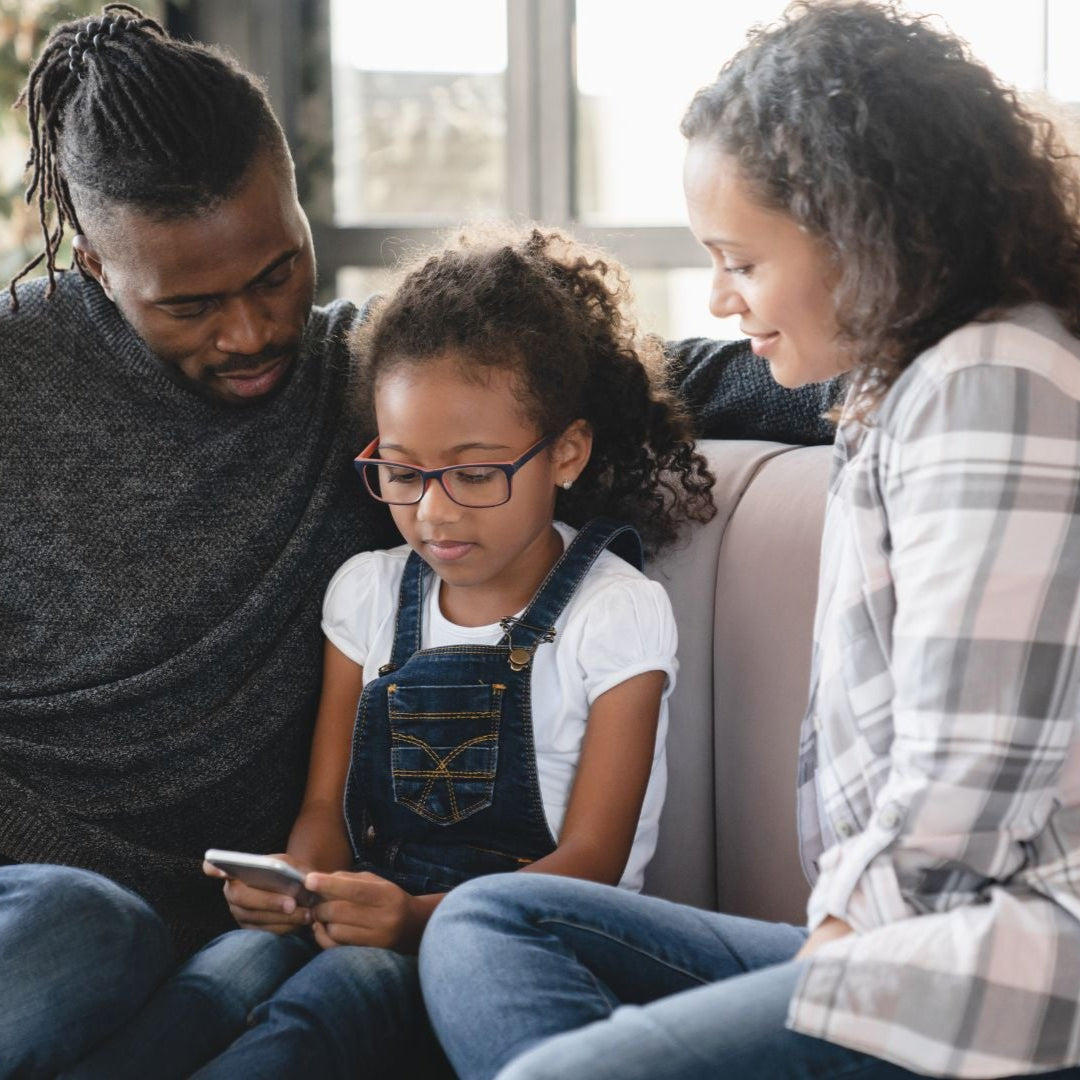
A feeling of comfort and coziness
Make it cozy
Make something nice to eat or drink, and find a cozy spot and create a warm atmosphere. Some children will find sitting next to you on the sofa, rather than making direct eye contact, makes it easier for them to converse. Others will enjoy doing the cards at the dinner table. You know your child best. Consider this time to be together important and enjoy it.
Be present
When doing the cards, try to keep negativity, work stress, complaining and anything that can be subtly divisive out of the hygge space (this means inside your head too). Think ‘we time’, not ‘me time’.
Avoid ‘telling’
If you feel yourself getting into the mode to ‘tell how it is’ remember that this often makes kids say ‘yes, yes’ without really listening or staying open minded. Having the tone of ‘I know best and you should do it this way’ is not hygge and can irritate or even provoke some children. There will be so much we don’t know about technology and that’s ok! Try to get comfortable becoming cleverer together, rather than ‘telling’.
Hygge not homework
When it feels like it’s getting to be too much information or unpleasant, stop. The cards are meant to be done over a period of time, not all at once. It’s all about the approach and mood. Above all, it should be a cozy ‘hyggeligt’ experience, so gauge when to say when.
A feeling of comfort and coziness
Make it cozy
Make something nice to eat or drink, and find a cozy spot and create a warm atmosphere. Some children will find sitting next to you on the sofa, rather than making direct eye contact, makes it easier for them to converse. Others will enjoy doing the cards at the dinner table. You know your child best. Consider this time to be together important and enjoy it.
Be present
When doing the cards, try to keep negativity, work stress, complaining and anything that can be subtly divisive out of the hygge space (this means inside your head too). Think ‘we time’, not ‘me time’.
Avoid ‘telling’
If you feel yourself getting into the mode to ‘tell how it is’ remember that this often makes kids say ‘yes, yes’ without really listening or staying open minded. Having the tone of ‘I know best and you should do it this way’ is not hygge and can irritate or even provoke some children. There will be so much we don’t know about technology and that’s ok! Try to get comfortable becoming cleverer together, rather than ‘telling’.
Hygge not homework
When it feels like it’s getting to be too much information or unpleasant, stop. The cards are meant to be done over a period of time, not all at once. It’s all about the approach and mood. Above all, it should be a cozy ‘hyggeligt’ experience, so gauge when to say when.

Subheading
Heading
Use this text to share information about your brand with your customers. Describe a product, share announcements, or welcome customers to your store.
Interested in learning more?
Try our kit today and start the conversation???

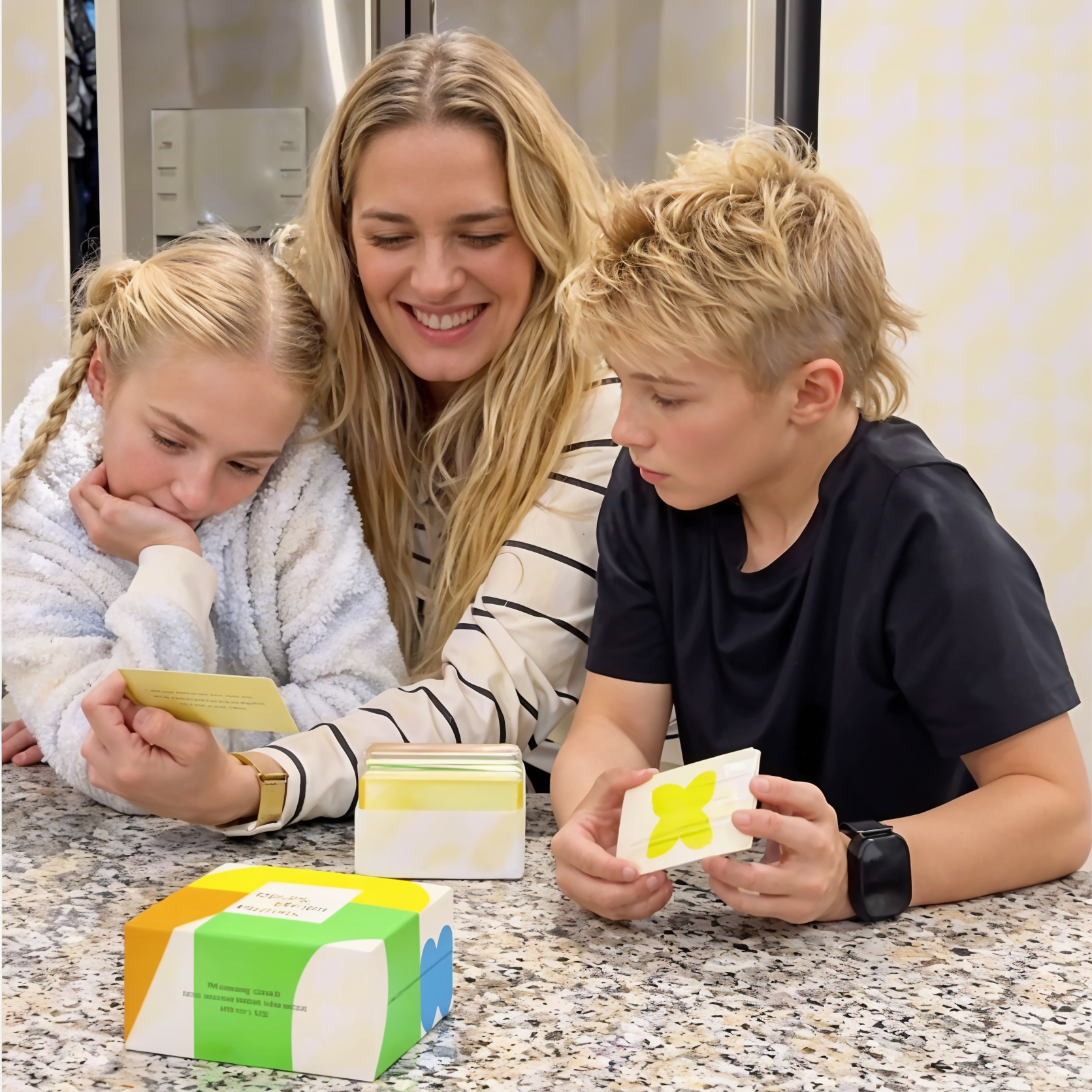

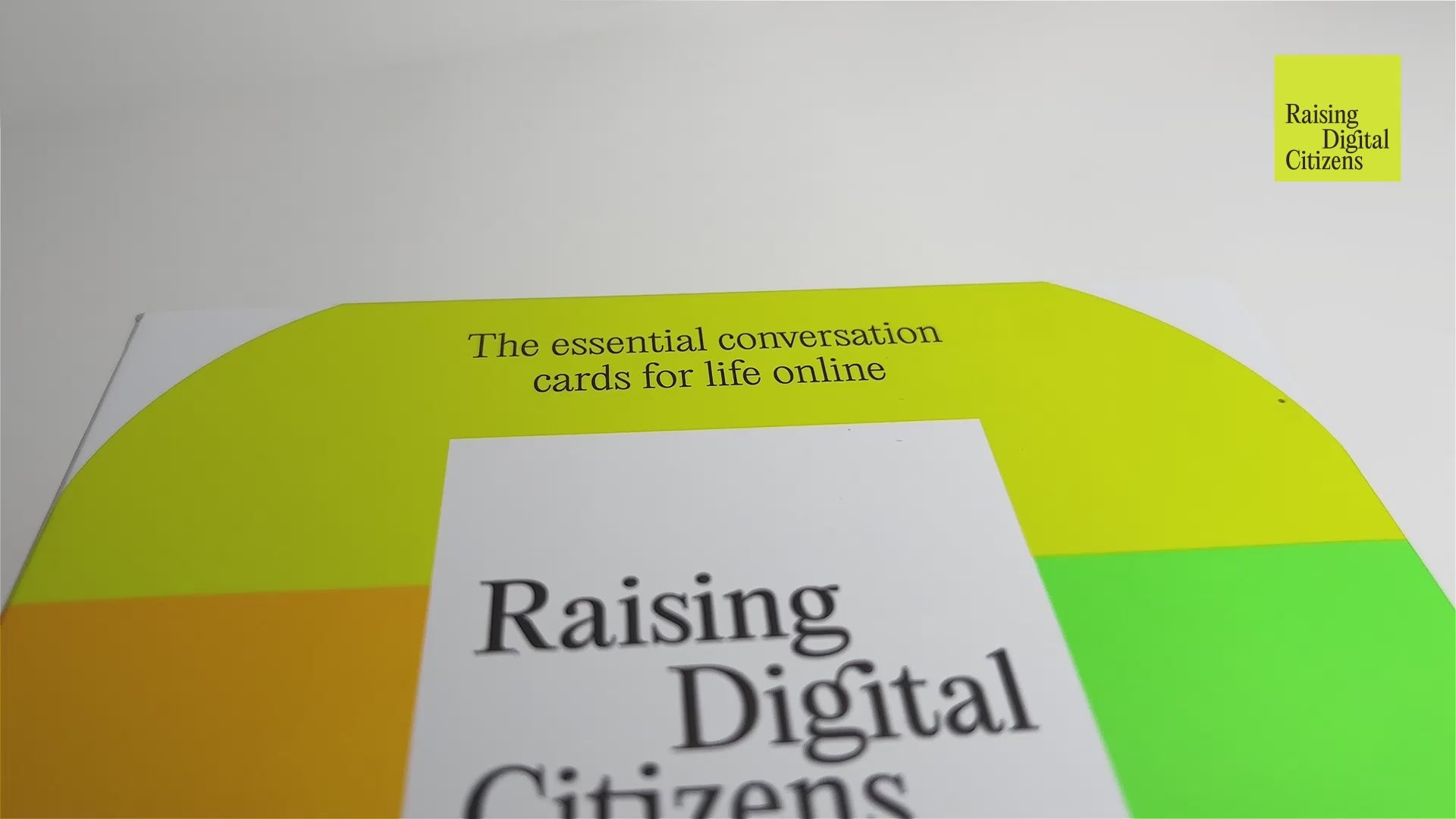
With our kit:
- Build trust so your child comes to you when things go wrong
- Learn together in a fun way what it means to be a good person online
- Empower against predators, scams, and manipulation
- Protect from peer pressure and pranks
- Avoid conflicts by creating screen-time boundaries together
- Reduce anxiety and build resilience for the whole family
Teach kids to think before they click... even when no one is watching.
